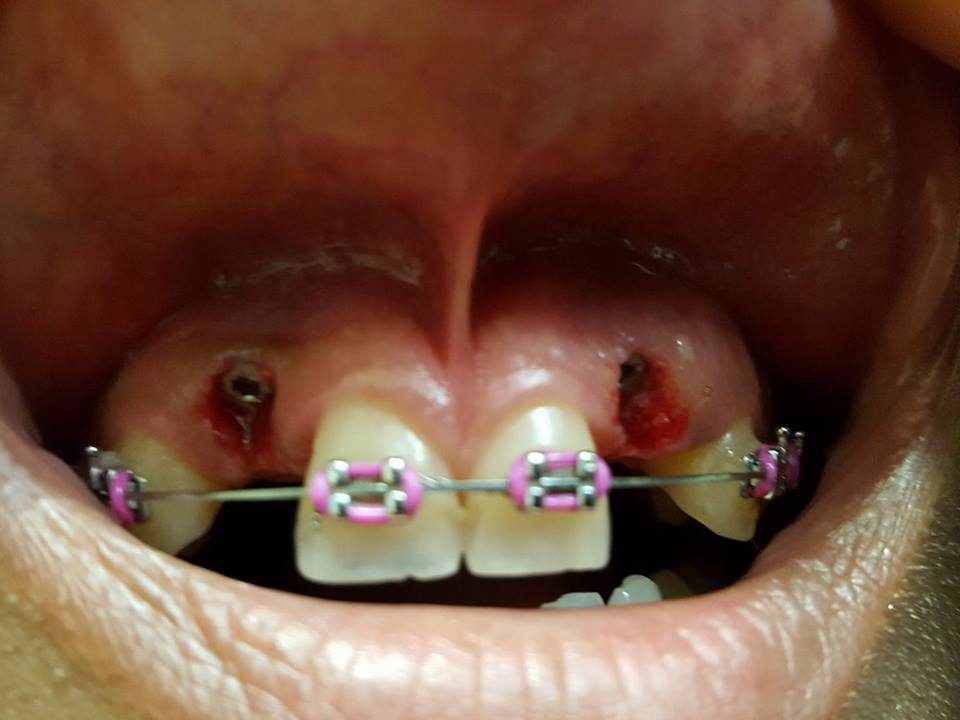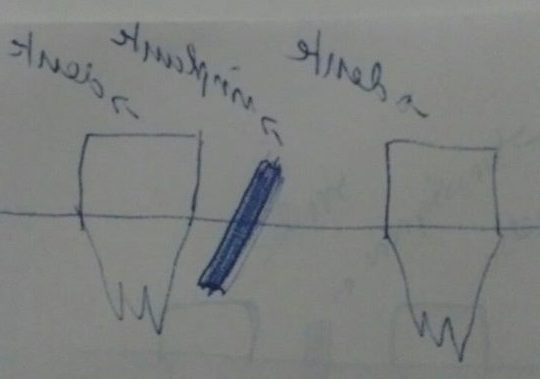The dental surgeon needs to plan very well the installation of the dental implant so that it is in or very close to the ideal three-dimensional position. If this is not done, the results can be catastrophic, causing great emotional and financial damage to the patient. See below cases where patients said that the dental implant was poorly done:
Case 1: This patient came to us asking if her case would be okay, because she suspected that the implants was poorly done.

And she is right to be worried, the implants are really not well positioned, besides, they are HI (internal hexagon) a type that unfortunately is often used but has a number of disadvantages compared to the morse taper. In the HI implant (even more so in the HE – external hexagon), there is infiltration of oral fluids between the prosthetic pillar and the implant (this causes contamination of this region and inflammation of the gums, which can lead to migration of this tissue, thereby exposing the implant platform or even the threads, causing infection and serious aesthetic problems).
We said that her case has a solution, we would need to order a CT scan (exam that shows the bone height and thickness, without this exam you should not do implants) and, if there was enough bone, we would remove the HI implants, install morse taper implants (these are more modern implants, they have a much greater stability between the components and make the infiltration of oral fluids much more difficult), we would do bone graft with Bio-Oss (bovine bone) and we would place a membrane (Bio-Gide) to protect the graft. After the healing period, we would assess the need or not for a gum graft. After the gum grafting, we would work on the emergence profile (design that the prosthetic abutment must describe to simulate the contour of a natural tooth), make a customized abutment, and most likely finish with a high-level porcelain crown, simulating a natural tooth.
Case 2: The patient was concerned about the tilt and position of the implant they placed in him on a course. “If it occurs to be tilted, making an angle of about 70°, does it have a stability problem?”
Photo sent by the patient

No. It has to be in the optimal three-dimensional position. Respect adjacent structures such as roots, nerves, glands, and the maxillary sinus. Be at least 1.5 mm from the roots of adjacent teeth, distant from the cervical margin of the future crown about 4 mm or more, be morse taper if it is an anterior region, inwards about 2 mm in relation to the buccal surfaces of the adjacent teeth. The gum is not a parameter, nor is the bone. If you do not have enough bone to house it in the optimal three-dimensional position, a bone graft may be indicated. If it is too close to the adjacent tooth, less than 1.5 mm, the possibility of removing it and making another one should be studied. If they have not implanted too close to the adjacent tooth and it is not too far forward or showing the platform, you can use an angled abutment to correct it.
Patient: “The problem was that, because I didn’t have the money to do it with an experienced professional, I did it in a school, with students. The student who did it showed total insecurity, she kept asking questions all the time, it was badly done”.
Josh: This happens even with trained professionals. You have to study hard to do it right.
Patient: “She had no notion of space, she didn’t know how to place between the two teeth”.
Joshua: It seems to be very close to the back tooth but you would need to take an X-ray to better evaluate.
Patient: “I saw the x-ray, it was as I did in the drawing, tilted, close to the root of the neighboring tooth. I don’t know the distance in millimeters.

Josh: I believe you don’t need to take it off, but you would still need to see an RX
Patient: “If I remove the implant, will I lose it? Do you have to buy another one?”
Josh: If you have to take it out, you can’t take advantage of the implant. You have to put in a new one.
Patient: “Yesterday they put in this piece, I think it’s called an abutment, it feels like pressure. It is whitish all around. Should I go there today to check it out?”
Joshua: Only if it hurts. It is ischemic because of the pressure on the gum. But it will pass. If it’s not hurting, you don’t have to go. If the implant is not less than 1.5 mm away from the back tooth, it does not need to be removed.
Patient: How is the teacher going to make this measurement? Is it by X-ray?
Joshua: Yes
Patient: Got it. At the next appointment I’ll try to talk about it. I am very worried about it.
Case 3: The patient reports that he had dental implants 2 years ago and on the CT scan he presented problems.
Good Morning,
What’s up?
If you really need braces, it can be done, but if there is no indication for braces in your case, and there is enough space in the implant region for installation, the correct thing to do is to remove the implant and place a new one in the correct position.
5 – Good morning Doctor. My crown keeps coming loose. Can I say that my dental implant was done badly?
Answer: Some types of implants have a high rate of screw loosening, which makes the crowns move. This occurs mainly with the he (external hexagon) and hi (internal hexagon) implants. The first solution is to make an occlusal adjustment (wear the crown if it is high), if this does not solve the problem, the implant must be removed and a morse taper implant must be installed in its place.
6 – The screw of the dental implant broke inside the pin, due to an erroneous procedure by the dentist.
Is there a problem if I decide to abandon the new placement, leaving the pin implanted?
Doctor: Is the implant sticking out of the gum?
No
Doctor: Then it will most likely be a problem. Most likely it will inflame the region.
Even if it’s already integrated?
Doctor: Yes. Oral fluids will enter this space between the implant and the surface of the gum and this fluid contains bacteria that will cause inflammation in the region.

